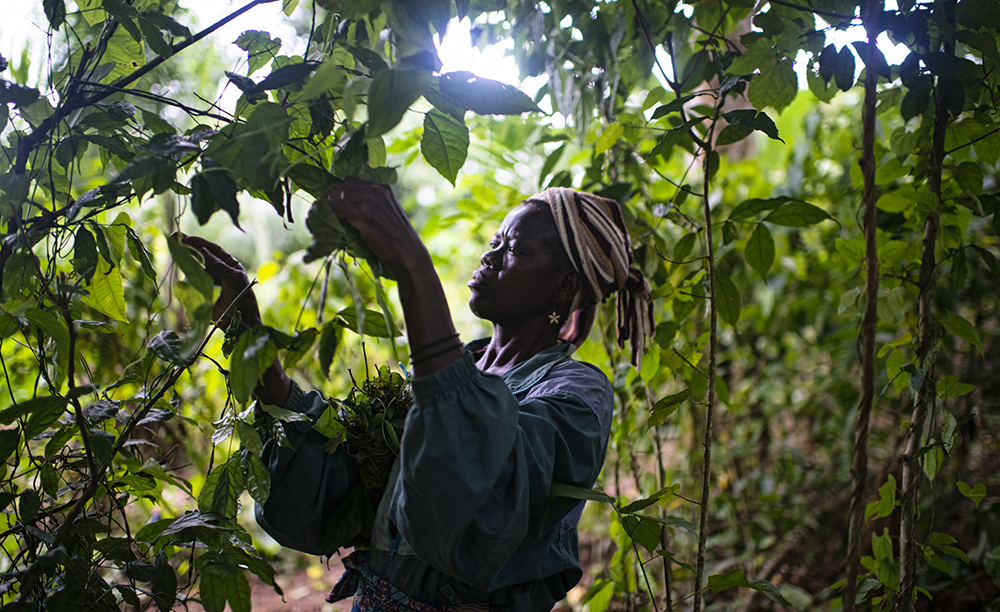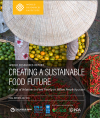Cross-Cutting Policies for a Sustainable Food Future (Synthesis)

Cross-Cutting Policies for a Sustainable Food Future (Synthesis)
-
The menu items for a sustainable food future, described and analyzed in our five courses, focus heavily on technical opportunities. However, menu items cannot be implemented in isolation, and they are all subject to a variety of cross-cutting public and private policies. In addition to reducing demand growth and boosting productivity, policies must reduce rural poverty by helping smallholder farmers become more market-oriented, even as many of them inevitably shift toward alternative employment.
Boost Productivity and Reduce Rural Poverty
Higher rural incomes will depend on raising the productivity of smallholder farmers and linking them to more lucrative markets. Progress will require giving farmers greater security to invest in producing marketable products where they have a comparative advantage, securing their land rights, and rectifying historical disadvantages confronting women farmers.
Allow farms to grow based on market and social forces, but avoid large or government-facilitated acquisitions unless they involve existing large farms
About 80 percent of the world’s farms are small (less than 2 hectares), but they occupy only about 12 percent of the world’s agricultural land.99 The number of small farms is growing, as families subdivide their land and some farms become too small to supply a full-time livelihood. Small farmers face real obstacles in the form of limited access to capital for productivity improvements, difficulties in meeting the tight sanitary and quality standards required by supermarket chains, and poverty traps that force farmers to sell critical assets in tough times. Yet in Africa and Asia, studies have consistently found small farms to be more productive per hectare than larger farms100 (though sometimes not the largest farms).101 More successful small farms tend to have market access and opportunities for off-farm employment to supplement income generated by the farm. Overall, government policies should not force small farms to consolidate or encourage large farms to take over small farms, but neither should they fight the autonomous growth of farms.
This less interventionist policy should also apply to large land acquisitions, which some governments have encouraged in recent years. The size and number of such deals is hard to track, and some early estimates were too high. The best information is that international investors acquired ownership or long-term leases for 44 Mha of land between 2000 and 2016 and are in some stage of agreement to acquire another 18 Mha.102 Major domestic investors are also acquiring large tracts of land. Although some acquisitions claim to be focused on supplying food for domestic markets, bioenergy production and to a lesser extent producing food destined for foreign markets motivated many transactions.
Acquisitions of preexisting large farms, including abandoned large farms in much of the former Soviet Union, raise few social or environmental concerns. In other parts of the world where small farms predominate, careful analyses have shown mostly adverse consequences for local people despite a variety of claimed social protections.103 Large acquisitions often involve land that is not intensively cropped but is used by local people for grazing, fishing, and long-rotation cropping. Many acquisitions of forested or other wooded land and wetlands are, in effect, forms of environmentally harmful agricultural expansion.
Move toward more equitable and secure property rights, and facilitate cash crop production through cooperative and contract farming
In much of the world, farmers and forest dwellers lack the secure, registered titles to property that are common in Europe and North America. Many researchers, international aid agencies, and nonprofit organizations have long advocated for stronger recognition of property rights to protect farmer interests and sometimes increase access to credit. However, as the World Bank found in 2008, efforts to shift to Western-style property rights “were often adopted less to increase efficiency than to further interests of dominant groups” and resulted in greater land consolidation and inequality.104 Many scholars also found that shifting to more official land titling in Africa often did not result in productivity increases, in part because customary rights are more secure than previously thought.
Recent efforts have emphasized recognition of customary rights, including shared rights to use land and trees, and the need for formalization of rights to correct historical inequities, such as the exclusion of women from ownership of or decision-making about land. Information technology has reduced the physical difficulties of mapping and registering land but governments need to reduce the bureaucracy and legal obstacles that still block the award of community rights in many countries.105
Governments also should establish legal frameworks and basic social security systems that make it easier for small farmers to raise high-value cash crops through contract or cooperative farming.106 Farmers can overcome the challenges of small size by linking, in various forms, to larger organizations through contracts or farmer associations. Such arrangements offer potential advantages of branding, access to expertise, shared or lower costs for inputs, and access to more specialized markets. But the costs can sometimes include lower prices imposed by a local monopoly, unfair or inefficient cooperative management, and potential cheating by either party to the contract as prices fluctuate. As a result, these systems tend to focus on high-value food or other cash crops, where high quality or reliability is rewarded by the market.107 Developing country climates often favor such crops, but, while they are potentially more profitable, specialization can also increase risk due to disease, changing market conditions, or dishonest purchasers. Legal frameworks that fairly enforce contract farming and support basic incomes for rural workers can help small farmers focus on growing more lucrative products, raise incomes, and possibly help reduce global land demands.
Climate Policy and Agriculture
Because no government can know the relative feasibility of all actions to reduce GHG emissions, sound, cost-effective climate policies typically mandate outcomes rather than technologies or practices.
The role of carbon pricing, emissions caps, and carbon offsets
Many governments and economists favor putting a price on emissions via a carbon tax or cap-and-trade system. Each emitting source then has an incentive to reduce emissions as cheaply as possible. Unfortunately, applying this approach to land-use and agriculture faces practical problems. Monitoring emissions from diverse and diffuse sources is not feasible (unlike tracking the quantity of coal or oil burned). Also, it is often not feasible to determine which changes in soil or forest carbon are caused by the landowner, the weather, or the actions of others.
Creative pricing programs therefore have to be designed for features of the agricultural system that can be measured. For example, governments could impose a tax on fertilizers that do not incorporate a nitrification inhibitor or time-release mechanism (assuming these alternative fertilizers are available to farmers). The tax level would be based on the difference in emissions expected from use of conventional versus improved fertilizer. Different forms of manure management could also be taxed differentially. Retail food taxes on high-emissions foods would also help internalize climate costs and could be offset with subsidies for low-emissions foods.
For many years, climate mitigation policies for agriculture focused on their potential to provide offsets to mitigate fossil energy emissions. The hope was that energy users could pay farmers to reduce emissions more cheaply than they could themselves, and that these practices would, in turn, help farmers boost productivity and resilience. The Clean Development Mechanism recognizes a small number of agricultural practices as offsets,108 and the Canadian province of Alberta recognizes many more in a local program.109
Unfortunately, agricultural offsets mean that reductions in the agricultural sector are credited to the energy sector and allow more emissions there, so they cannot count as agricultural mitigation. However, stringent climate goals require sharp reductions of emissions in both sectors. Agricultural offsets also present large administrative challenges. By definition, an offset must require “additional” reductions in agricultural emissions, but additionality is subject to uncertainty. The more cost-effective the mitigation, the greater the likelihood that it would occur anyway and therefore not be additional. Leakage and monitoring requirements are significant, and small farmers often cannot afford to invest money to reduce emissions up-front while waiting to be paid only after they have reduced emissions or sequestered carbon. As discussed above, soil carbon sequestration turns out to be harder and more uncertain than expected. In the short term, some offsets could stimulate progress in the land sector but, at best, offsets have a limited and temporary role to play in achieving a sustainable food future.
Redirect government farm support and attract climate funding
Farming, like any other large industry, requires major investments. The direct investments made by farmers with their own funds or by other domestic private investors account for the overwhelming share of agricultural investment.110 Policies that facilitate and guide this private investment are therefore more important than direct public funding.
Yet public funding is still important. In 2014–16, public support for agriculture averaged $600 billion per year in countries assessed by the OECD (Figure 24). Half of this total takes the form of market interventions that raise prices to consumers, such as import barriers, tariffs, or systems that limit production by farmers to increase prices. Because these supports are more prevalent in higher-income countries, they offer little market protection for the world’s poor. Few of these funds support the menu items identified in this report. From a global perspective, reducing or redirecting the costs of these market interventions would reduce prices and benefit consumers. Many farmers in lower-income countries do, however, benefit from large fertilizer subsidies. The environmental benefits of reducing overapplication of cheap fertilizers are clear in countries where fertilizers are heavily overused. In much of Africa, where soils are nutrient-poor, subsidized fertilizers have achieved only modest yield gains or helped to reduce poverty, though at significant cost to government budgets.
Over the years, countries have reduced some market barriers and linked subsidies to very modest conservation requirements, but funding could do much more to support the interventions needed for a sustainable food future. The most promising examples involve government support for multipartner research projects to promote new farming practices.
Developed countries have promised to provide $100 billion per year by 2020 to developing countries for climate mitigation and adaptation. To date, they are not on track to meet this goal.111 For example, as of September 2017, only $10 billion had been committed to the Green Climate Fund.112 The money is for all climate-related work. If agriculture is to earn its fair share of climate funding, countries are going to need to demonstrate they are implementing detailed, scientifically based plans to mitigate emissions, identify the specific farming changes that will be implemented on specific types of farms, and the likely gains that will result.
Figure 24 |
The world’s leading agricultural producers provided nearly $600 billion in public funding to support farms in 2015
Note
OECD assessment of 51 countries excluding India.
Source
WRI analysis of OECD (2016) data.
Boost Research and Development
Total public and private spending on agricultural research and development (R&D) in 2007–8 (the latest year for which we found global data) was roughly $50 billion.113 Today, the world probably devotes only around 1.4–1.7 percent of agricultural GDP to agricultural R&D.114 For a sector that is so sensitive to constantly changing environmental conditions and in which massive growth is required, we consider this amount to be inadequate. We identify two key research and development themes.
Development: The world needs to commit far more resources to the D in R&D for agricultural emissions reduction. “Development” involves the critical technical analyses concerning how to apply research breakthroughs. Researchers know how to draw down water in rice farms and can roughly estimate the emissions reductions, but they do not know which specific irrigation districts have sufficiently reliable water supplies to make drawdowns feasible. Researchers know that improved feeds and health care will increase the productivity of ruminant livestock, but, outside of developed countries, they have only the roughest proxy estimates for how livestock systems work and how they can be improved. Countries have not developed scientifically based land-use plans for targeting agricultural expansion where it is inevitable. Governments and international institutions should fund this kind of development.
Indispensable innovations: We identify multiple examples of technological progress or breakthroughs that are either indispensable or would be enormously helpful in achieving a sustainable food future (Table 5). A few, such as the pursuit of plant-based meat substitutes appetizing to meat eaters, can probably be left mostly to the private sector, but others will require public investment. Governments can also spur innovation by funding pilot projects—particularly large-scale pilots—to use innovative technologies, and by enacting laws to require the use of innovations if they prove effective and cost-efficient.
Table 5 |
Critical research needs for breakthrough technologies
Note
This table is not intended to be exhaustive and does not include all courses or menu items.
Source
Authors.
Avoid Double Counting of Land and Biomass
Some of our menu items differ from other researchers’ recommendations where we believe those recommendations are based on analyses that inappropriately count the same land or plant material (biomass) twice. In other words, some other analyses assume that the same land or biomass required to meet one set of needs is simultaneously available to meet another.
Prominent examples include bioenergy from food or energy crops grown on dedicated land. Many analyses assume that “potential cropland” or “marginal cropland” can be used to produce bioenergy without recognizing their current carbon storage and biodiversity values as forest or savannas, or their current food production function as grazing land. Modelers who estimate large potential climate benefits from “bioenergy with carbon capture and storage” (BECCS) rely on the same estimates of biomass potential that are based on double counting.115 Other analyses assume yield gains could be used to free up land for bioenergy without clearing more forests and savannas—even as those same yield gains are needed just to meet rising food demand. In claiming GHG savings from bioenergy, analyses often attribute the carbon absorbed by plant growth as an offset for burning biomass even when this plant growth would otherwise have occurred and removed carbon from the atmosphere anyway (Figure 25).
Large estimates of reforestation potential often make similar mistakes in treating grazing land as available to reforest without cost to food production, or regarding potential increases in crop and pasture productivity as automatically liberating land for reforestation without recognizing that this potential must first be exploited just to meet growing food needs. Although important restoration opportunities exist on peatlands and unimprovable grazing land, large-scale reforestation will require significant reductions in demand growth and historically unprecedented increases in yields.
Some soil carbon sequestration estimates also double-count by assuming that biomass (as manure, crop residues, or mulches) can be used as a soil amendment when it is already in use—even if only to store carbon—somewhere else. Other estimates count the benefits of reducing grazing pressure without counting the costs of replacing the forgone meat and milk.
A common theme appears to be a failure to recognize that land is a fixed and therefore limited resource. The only ways to meet growing human demands for both food and carbon storage are to use land more efficiently and to consume agricultural products more efficiently.
Figure 25 |
Why greenhouse gas reductions from bioenergy require additional biomass
Note
In scenario A, shifting from gasoline to ethanol use reduces emissions through additional uptake of carbon on land that previously did not grow plants. In scenario B, which is the typical bioenergy scenario, the shift from gasoline to ethanol does not reduce emissions, as the demand for bioenergy merely diverts plant growth (e.g., maize) that would have occurred anyway.
Source
Searchinger and Heimlich (2015).
- 99Lowder et al. (2016).
- 100Deininger et al. (2011); Ali and Deininger (2014); Larson et al. (2014).
- 101Place (2009).
- 102Land Matrix database (n.d.).
- 103Schönweger et al. (2012); Pearce (2012).
- 104World Bank (2008).
- 105Notess et al. (2018).
- 106Bellemare (2015).
- 107Bellemare (2015).
- 108CDM allows European companies responsible for cutting their emissions to obtain credit as an alternative for paying for actions in developing countries that cut their emissions. Only a few potential agricultural practices have qualified under CDM methodologies, mostly including managing of manure or wastes, or planting trees on agricultural land. As of 2011, one study found that agriculture or other land-use projects were expected to generate less than 1% of total CDM projects. Larson et al. (2012).
- 109The Alberta system allows offset credits for changes in cropping systems, three ways of increasing feeding efficiencies, various efforts to reduce nitrous oxide, improvements in dairy cow efficiency, and capture of biogas from manure, wind energy, and energy efficiency. Alberta Agriculture and Forestry (2015).
- 110FAO (2012b).
- 111Roberts and Welkmans (2016).
- 112Green Climate Fund (2017).
- 113Beintema et al. (2012); Fuglie et al. (2011).
- 114The world devotes 2.23% of total GDP on R&D in all sectors in 2015 (World Bank [2017c]), and a strong case can be made to increase research funding across all sectors generally (Griffith 2000). By contrast, world agricultural GDP was $3.62 trillion in 2014 according to the World Bank (2017d). If agricultural R&D were still $52 billion, the percentage would be roughly 1.4% ($50 / $3,620 = 0.014).
- 115Searchinger et al. (2017) review 12 modeling analyses of BECCS. In 9 of them, biomass is automatically treated as carbon neutral and effects on terrestrial carbon storage are not counted. In 3 models, the modelers project carbon mitigation potential but only at high cost and only based on a number of unlikely conditions, including that governments worldwide perfectly protect forests and other high-carbon lands. The combination of this protection and high bioenergy demand saves land in the different models either because the cost of ruminant products rises so high that hundreds of millions of hectares of grazing land are converted to bioenergy or because governments also spend large sums of money to intensify agricultural production on existing agricultural land.

